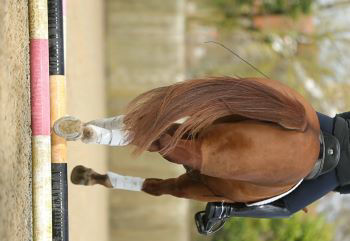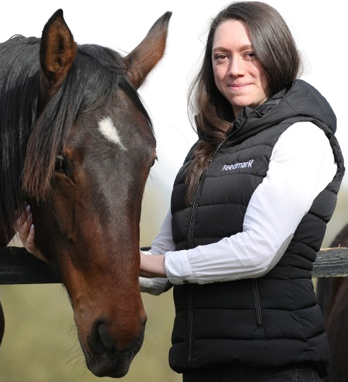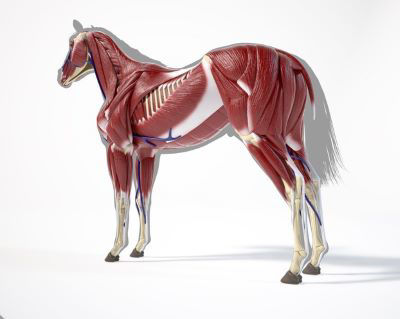Written by Sophie Pelham Burn (MMedSci ANutr.)
We often think of muscle fatigue in horses as a bad thing, but it is actually a normal part of exercise. In the context of training, microdamage caused by fatiguing the muscle actually creates the physiological adaptations that result in fitter, stronger horses with a better endurance capacity.
When working a muscle beyond its current capability, either through increasing the horse's training load (working harder) or the duration (working for longer periods of time), several things happen on a cellular level instigated by both metabolic and mechanical stress. Mechanical stress refers to damage in the horse's muscle fibres, called myofibrils, which occurs due to repeated contractions of the muscle while metabolic stress relates to the accumulation of molecules that result from converting fuel to energy.
What Causes Exercise Induced Fatigue in Horses?
The Role of Mitochondria and Oxygen in Muscle Fatigue
Within the horse's working muscle cells, organelles called mitochondria are responsible for combining the fuel source, either carbohydrate or fat, with oxygen to create energy in the form of ATP. Delivery of oxygen to the mitochondria is usually the rate limiting factor in this equation and if oxygen is not able to be delivered quickly enough, the muscle will accumulate an ‘oxygen debt’ and produce lactic acid as a result.
Hypoxia and the Stimulation of Muscle Adaptation
This state of hypoxia stimulates the production of two specific types of protein, Vascular Endothelial Growth Factor A (VEGF-A) and Fibroblast Growth Factor 2 (FGF2). The presence of these two proteins in the muscle stimulates the growth of capillary vessels into the area which, over the long term, results in increased blood flow and therefore oxygen delivery to the horse's working muscles. The number and density of mitochondria in the horse's muscles will also increase, allowing greater capacity for energy production at any given moment.
The Impact of Reactive Oxygen Species and Antioxidants
Reactive Oxygen Species (ROS) are a type of metabolic waste product that are free radicals and cause damage to cell walls in the muscle but also surrounding tissues. To combat this, antioxidants are produced in response to their presence with the main ones being the Superoxide Dismutase (SOD) and Glutathione peroxidase (GPx) families of enzymes. Although these are produced in response to ROS, they can travel all around the horse’s body in the blood stream and reduce oxidative damage in various other tissues as well as muscle, leading to improved overall health.
Muscle Adaptation and Fibre Type Shifts in Response to Training
Mechanical muscle damage stimulates increases in the numbers of muscle fibres and the horse's overall muscle mass, as well as changes to the types of muscle fibres. Type II muscle fibres are capable of switching between type IIA and IIX, each with their own characteristics, in response to training. While type IIA are more suited to endurance and speed activities, type IIX are ideally adapted to high power output.
The Role of Vitamins in Supporting Your Horse's Muscle Recovery
To help our horses optimally recover from exercise a balanced diet is essential, i.e., one that meets their viatmin, mineral, and amino acid requirements.
To maximally stimulate beneficial adaptive responses the amino acid building blocks required to build new muscle proteins and antioxidant enzymes need to be supplied by the diet. B vitamins and selenium, as well as copper, zinc, manganese and iron are essential components of the antioxidant enzymes. While most of these are abundantly available in the horses’ usual diet, selenium levels vary depending on the soil concentration where the forage was grown so supplementation may be advisable.
Vitamins C and E work in tandem to neutralise free radicals. Unlike humans, horses can synthesise their own vitamin C in the liver, however, vitamin E must be obtained from the diet, predominantly from fresh forage so if access is restricted for any reason additional support may be warranted.

Balancing Training Intensity and Horse Fatigue to Prevent Injury.
Do bear in mind that while working horses to muscle fatigue as part of a balanced training plan may be beneficial for overall fitness, strength and endurance, there is also a strong psychological component to fatigue. Tired horses are more likely to trip, stumble, or have slower reaction times, eg, when taking off in front of a fence. It is always wise to pay close attention to your horse’s way of going and stop or reduce the intensity of the training session if you notice any signs that they are beginning to struggle. Safety and managing the risk of injury is more important than continuing with a training session in an effort to rush progress.
Conclusion
Exercise-induced muscle fatigue in horses is not just an inevitable byproduct of training - it's a powerful driver of physiological adaptation and improved performance. When managed carefully within a balanced training plan, it can lead to stronger, more resilient muscles and enhanced endurance for your horse. However, recognising the signs of fatigue and supporting recovery through balanced nutrition, including key vitamins and minerals, is essential to prevent injury.
If you have any questions or would like any advice, please get in touch with our expert nutrition team, you can call 0800 585525, email [email protected], use the Live Chat function on our website, or send us a DM on social media.



